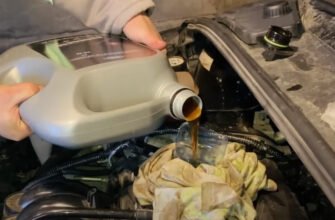Your vehicle’s heating system and cooling system though opposite work together. So if you’re experiencing an issue with your vehicle’s heating system, then there is probably a problem with the cooling system.
However, the lack of heat could be a sign of a much larger problem. There are many reasons for car heater failure and if your Ford Edge heater is not working, it is something you should take very seriously. If not checked and fixed on time, it could lead to a more serious problem that could require a pricey repair.

- Ford Edge Heater Not Working: Most Common Causes
- Ford Edge Heater Not Working: How to Fix
- 1. Top up the Coolant
- 2. Check and Replace the Thermometer
- 3. Check for Air Lock
- 4. Check for Bad Coolant or Loose Clamps
- 5. Check the Radiator
- 6. Check the Radiator Cap
- 7. Check the Water Pump
- 8. Fix or Replace the Thermostatic Switch
- Other Possible Fixes
- Wrap-up
Ford Edge Heater Not Working: Most Common Causes
- Low coolant levels
- Defective thermostat
- Presence of airlock
- Bad coolant hoses or loose clamps
- Radiator leak
- Faulty radiator cap
- Clogged heater core internal passages
- Clogged heater core exterior
- Faulty heater valves
- Issues with the blower fan
- Defective thermostatic switch
- Faulty water pump
Ford Edge Heater Not Working: How to Fix
1. Top up the Coolant
If your coolant is below the normal level, your heater core won’t get enough warm coolant through which it will produce adequate heat. This is actually a simple fix that even the average car owner can pull off. All you need to do is top up the coolant to see if it fixes the problem.
However, you should also check for leaks and get it fixed. A coolant leak could be due to a cracked hose or loose clamp. It could also be due to a head gasket leak. Such problems should be handled immediately as leaking coolant could overheat and damage your vehicle’s engine.
While at it, you should ensure that your coolant remains fresh. If not, the helpful additives in the coolant will wear and it will get contaminated. The contaminant particles could potentially clog the passages in the heating system.
2. Check and Replace the Thermometer
A faulty thermostat will delay warm-up up and impede heat production. To fix the thermostat, you should take the car to a mechanic who will test and replace it.
3. Check for Air Lock
An air lock is a large air bubble that could prevent the coolant from circulating properly and can restrict heat output. To get rid of it
- Set the heater to maximum
- Take out the coolant cap and ensure it is filled to the proper level
- Turn on the engine with the cap still open and let it idle for a few minutes
- If the coolant level drops as the thermostat open, top it up to the proper level again. This should get rid of the air bubble.
- With the engine fully warmed up, return the cap and test the car to see if the heat output is back to normal.
4. Check for Bad Coolant or Loose Clamps
With continuous use, the coolant hoses can deteriorate, become clogged, or get blocked. In addition, the clamp that secures the hoses can loosen over time which could lead to problems with heat production.
To check if your coolant hoses or clamps are the cause of the problem, you should perform a visual inspection of these parts. In older cars, you may notice that the hoses have a spongy feel which means they need to be replaced. This inspection should be done with the car off.
If the coolant hoses are showing signs of wear or look suspicious, they should be replaced. Also, ensure that all clamps are tight and check for any signs of leaks afterward.
5. Check the Radiator
The radiator could keep your coolant level too low which could hinder heat production. This is most common in older cars. You should be able to notice a radiator leak with ease. Look for puddles of coolant in your vehicle’s front area. You may also notice a dripping or wet section on the radiator.
Issues with the radiator should be checked by a mechanic. In some cases, the radiator may only need repairs, however, it could also need to be replaced.
6. Check the Radiator Cap
The radio cap is designed to regulate the pressure in the cooling system by acting as an escape valve if the pressure builds up to abnormal levels. If it stays locked in the open position, the system won’t have enough pressure, and the coolant won’t heat up to proper levels thus reducing heat production. To fix this, you would have to replace the radiator cap with a functioning one.
7. Check the Water Pump
If you’re using an older Ford Edge vehicle, the water pump could be the source of inadequate coolant circulation due to leaks. You should have a mechanic check the water pump to confirm its condition. You might need to get a replacement if it fails to work as normal.
8. Fix or Replace the Thermostatic Switch
To ensure proper additional engine cooling, most vehicles are equipped with a thermostatically-controlled electric fan that comes on at that moment. If the thermostatic switch is defective, it could make the fan run continuously, reducing the temperature of the coolant to the point where you won’t get enough heat in the interior. If the engine fan runs all the time even from a cold start, then this could most likely be the problem.
Solving this is as simple as replacing the thermostatic switch.
Other Possible Fixes
- Flush the Heater Core Internal Passages
- Clean the Heater Core Exterior
- Fix the Heater Valves
- Check the Blower Fan
Wrap-up
As you can see, there are a bunch of reasons why your Ford Edge heater could fail and there are also a set of fixes to get them solved. If you’re going DIY on your car, you would have to check out each possible cause and then apply the solution. This could take a lot of time, so it might be better to spend a little more and get a mechanic to check it out. They should be able to quickly isolate the cause and fix it right away.







